简单介绍
public class CompletableFuture<T> implements Future<T>, CompletionStage<T> {}
- 1
我们可以看到CompletableFuture实现了Future和CompletionStage接口,使用Future获得异步执行结果时,要么调用阻塞方法get(),要么轮询看isDone()是否为true,这两种方法都不是很好,因为主线程也会被迫等待。
从Java 8开始引入了CompletableFuture,它针对Future做了改进,可以传入回调对象,当异步任务完成或者发生异常时,自动调用回调对象的回调方法。当任务执行完之后,会通知调用线程来执行回调方法。而在调用回调方法之前,调用线程可以执行其他任务,是非阻塞的
使用
需求
从数据库查询所有用户id
根据用户id查询用户相关信息
获取信息后,处理信息
等待所有用户的信息处理完成后,完成下一步动作
在处理过程中主线程无需等待整个信息的处理完成
流程分析
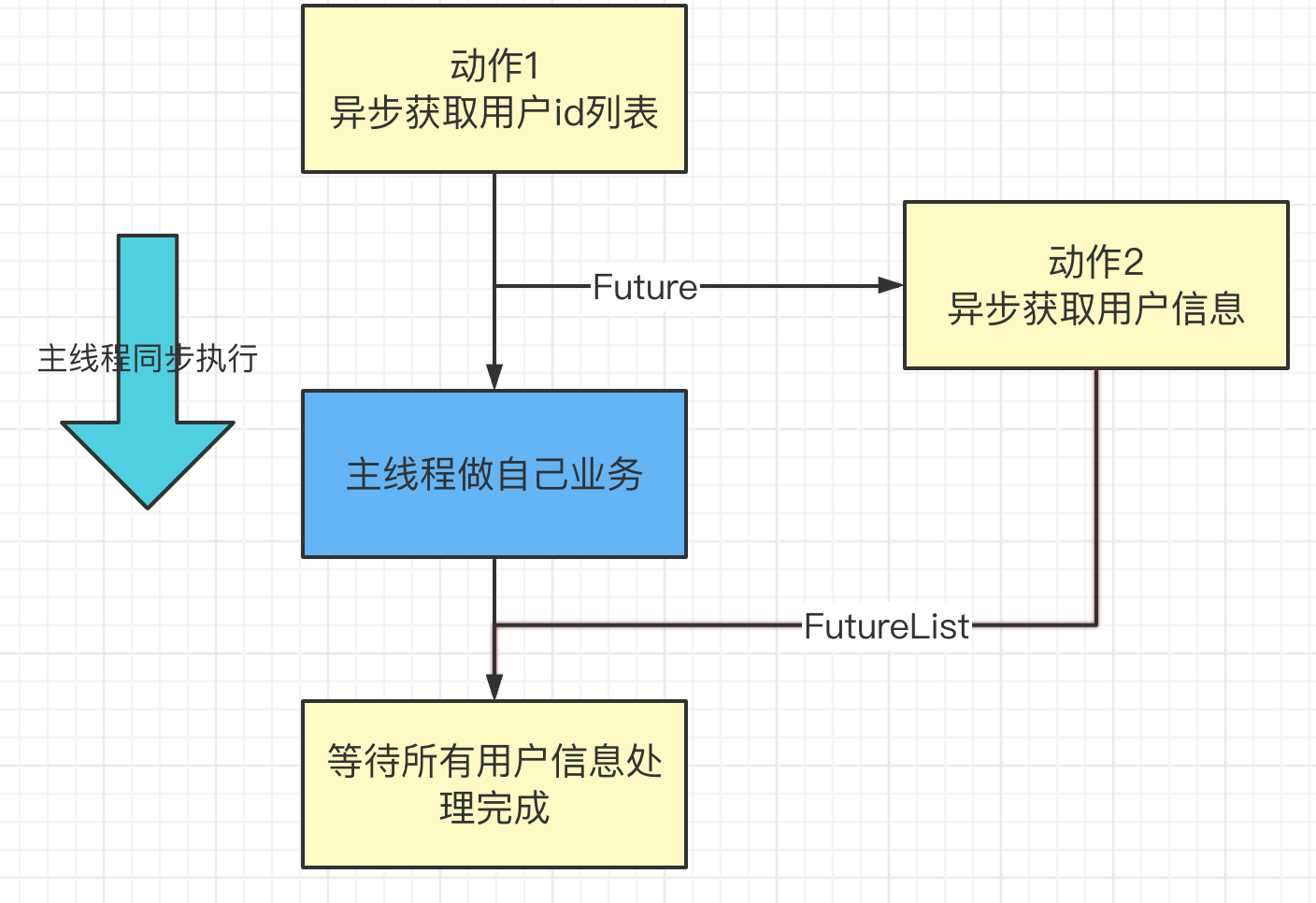
ThreadPoolExecutor代码实现
public class CompletableFutureTest {
private static final String USER_MSG_FORMAT = "用户信息%d";
private static final String USER_MSG_START_FORMAT = "正在获取用户%d的信息";
private static final String USER_MSG_END_FORMAT = "获取结束";
private static ThreadPoolExecutor threadPoolExecutor = (ThreadPoolExecutor) Executors.newFixedThreadPool(10);
public static void main(String[] args) throws ExecutionException, InterruptedException {
System.out.println(Thread.currentThread() + "\t" + "业务开始处理");
// 异步提交一个任务
Future<List<Integer>> useIdFuture = threadPoolExecutor.submit(() -> getUserIdList());
// 主线程执行自己的任务
mainThreadDo();
// 获取第一个任务的用户id
List<Integer> useIdList = useIdFuture.get();
// 接收所有异步获取用户信息的任务
List<Future<String>> list = new ArrayList();
// 异步提交用户信息任务
useIdList.forEach(userId -> list.add(threadPoolExecutor.submit(() -> getUserMsg(userId))));
// 等待任务执行完成
for (int i = 0; i < list.size(); i++) {
String useMsg = list.get(i).get();
System.out.println(useMsg);
}
// 主线程执行自己的逻辑
mainThreadDo();
threadPoolExecutor.shutdown();
threadPoolExecutor.awaitTermination(2, TimeUnit.MINUTES);
System.out.println(Thread.currentThread() + "\t" + "业务完成处理");
}
public static void mainThreadDo() {
System.out.println(Thread.currentThread() + "\t" + "主线程开始执行别的逻辑");
sleep();
System.out.println(Thread.currentThread() + "\t" + "主线程结束执行别的逻辑");
}
public static String getUserMsg(Integer userId) {
System.out.println(String.format(Thread.currentThread() + "\t" + USER_MSG_START_FORMAT, userId));
sleep();
System.out.println(Thread.currentThread() + "\t" + USER_MSG_END_FORMAT);
return String.format(USER_MSG_FORMAT, userId);
}
// 查询数据库并返回所有用户ID列表
public static List<Integer> getUserIdList() {
sleep();
return new ArrayList<Integer>() {
{
this.add(1);
this.add(2);
this.add(3);
this.add(4);
this.add(5);
}
};
}
// 为了模拟数据库延时操作
public static void sleep() {
try {
Thread.sleep(500);
} catch (InterruptedException e) {
e.printStackTrace();
}
}
}
- 1
- 2
- 3
- 4
- 5
- 6
- 7
- 8
- 9
- 10
- 11
- 12
- 13
- 14
- 15
- 16
- 17
- 18
- 19
- 20
- 21
- 22
- 23
- 24
- 25
- 26
- 27
- 28
- 29
- 30
- 31
- 32
- 33
- 34
- 35
- 36
- 37
- 38
- 39
- 40
- 41
- 42
- 43
- 44
- 45
- 46
- 47
- 48
- 49
- 50
- 51
- 52
- 53
- 54
- 55
- 56
- 57
- 58
- 59
- 60
- 61
- 62
- 63
- 64
- 65
- 66
- 67
代码挺复杂的,有没有更简单的方法呢,可以用CompletableFuture来做
public class CompletableFutureTest {
private static final String USER_MSG_FORMAT = "用户信息%d";
private static final String USER_MSG_START_FORMAT = "正在获取用户%d的信息";
private static final String USER_MSG_END_FORMAT = "获取结束";
public static void main(String[] args) throws ExecutionException, InterruptedException {
System.out.println(Thread.currentThread() + "\t" + "业务开始处理");
CompletableFuture<List<CompletableFuture<Void>>> completableFutureList = CompletableFuture.supplyAsync(() -> getUserIdList())
.thenApplyAsync(useIdList -> useIdList.stream()
.map(userId -> CompletableFuture.supplyAsync(() -> getUserMsg(userId))
.thenAccept(System.out::println)).collect(Collectors.toList()));
mainThreadDo();
completableFutureList.thenAccept(completableFutures -> {
CompletableFuture<Void> completableFuture = CompletableFuture.allOf(completableFutures.toArray(new CompletableFuture[0]));
completableFuture.thenRun(CompletableFutureTest::mainThreadDo);
});
Thread.sleep(5000);
System.out.println(Thread.currentThread() + "\t" + "业务处理完毕");
}
public static void mainThreadDo() {
System.out.println(Thread.currentThread() + "\t" + "主线程开始执行别的逻辑");
sleep();
System.out.println(Thread.currentThread() + "\t" + "主线程结束执行别的逻辑");
}
public static String getUserMsg(Integer userId) {
System.out.println(String.format(Thread.currentThread() + "\t" + USER_MSG_START_FORMAT, userId));
sleep();
System.out.println(Thread.currentThread() + "\t" + USER_MSG_END_FORMAT);
return String.format(USER_MSG_FORMAT, userId);
}
// 查询数据库并返回所有用户ID列表
public static List<Integer> getUserIdList() {
sleep();
return new ArrayList<Integer>() {
{
this.add(1);
this.add(2);
this.add(3);
this.add(4);
this.add(5);
}
};
}
// 为了模拟数据库延时操作
public static void sleep() {
try {
Thread.sleep(500);
} catch (InterruptedException e) {
e.printStackTrace();
}
}
}
- 1
- 2
- 3
- 4
- 5
- 6
- 7
- 8
- 9
- 10
- 11
- 12
- 13
- 14
- 15
- 16
- 17
- 18
- 19
- 20
- 21
- 22
- 23
- 24
- 25
- 26
- 27
- 28
- 29
- 30
- 31
- 32
- 33
- 34
- 35
- 36
- 37
- 38
- 39
- 40
- 41
- 42
- 43
- 44
- 45
- 46
- 47
- 48
- 49
- 50
- 51
- 52
- 53
- 54
- 55
- 56
- 57
CompletionStage接口方法介绍
依赖关系
// 当这个CompletionStage执行完毕后,返回一个新的CompletionStage,在这个新的CompletionStage中回调fn
public <U> CompletionStage<U> thenApply(Function<? super T,? extends U> fn);
// 和上面不同的是,拿到上个任务的执行结果后,回调的任务会放到默认线程池ForkJoinPool执行
public <U> CompletionStage<U> thenApplyAsync
(Function<? super T,? extends U> fn);
// 和上面不同的是,这个能指定线程池
public <U> CompletionStage<U> thenApplyAsync
(Function<? super T,? extends U> fn,
Executor executor);
// 当这个CompletionStage执行完毕后,返回一个新的CompletionStage,并在新的stage中调用action消费结果
public CompletionStage<Void> thenAccept(Consumer<? super T> action);
// 当这个CompletionStage执行完毕后,返回一个新的CompletionStage,并在新的stage中调用action,没有入参,也没有返回值。
public CompletionStage<Void> thenRun(Runnable action);
- 1
- 2
- 3
- 4
- 5
- 6
- 7
- 8
- 9
- 10
- 11
- 12
- 13
- 14
- 15
- 16
- 17
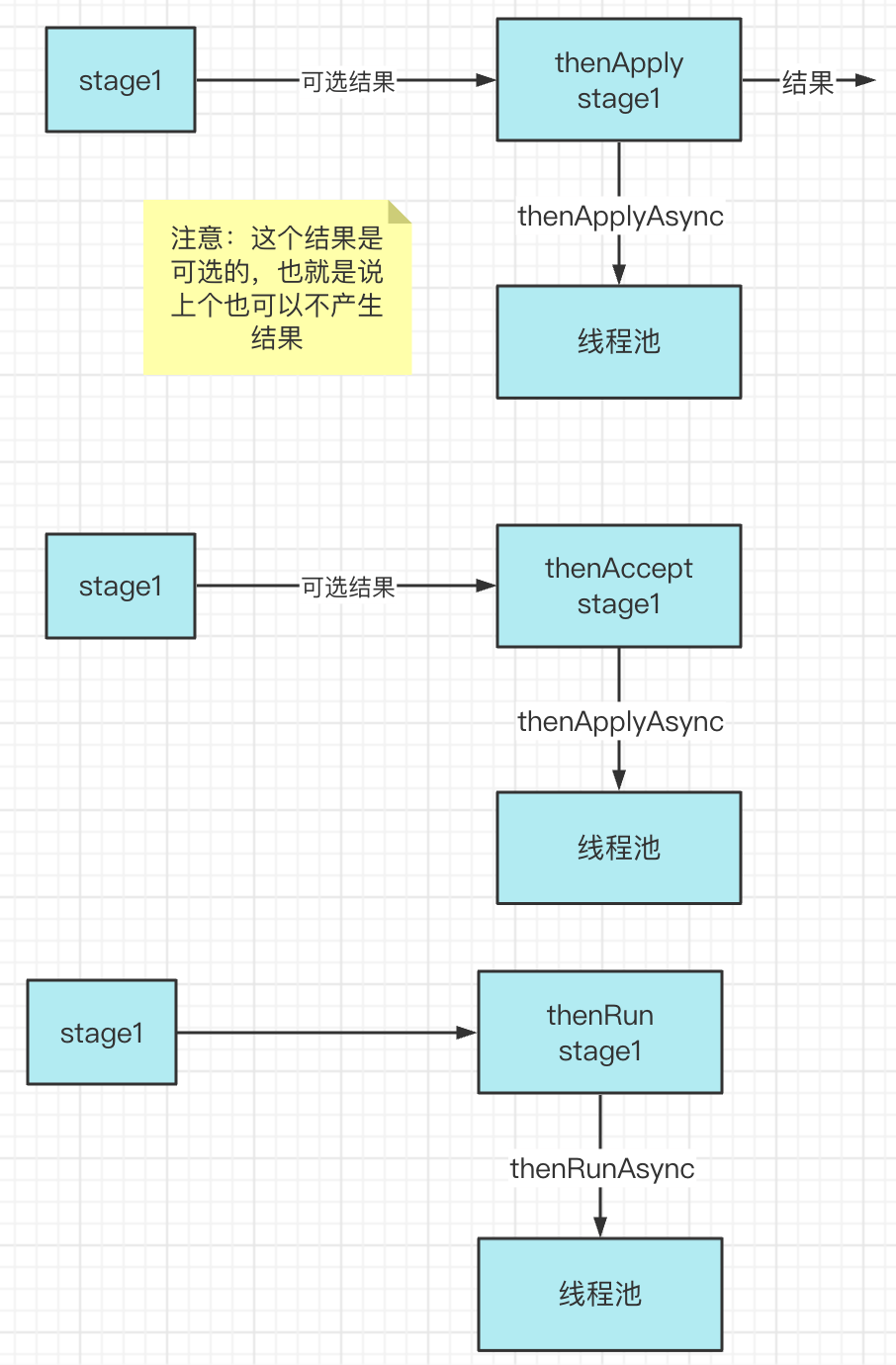
and集合关系
// 当目前的CompletionStage和thenCombine传入的thenCombine正常完成后,返回一个新的CompletionStage,并在新的stage中调用fn函数
public <U,V> CompletionStage<V> thenCombine
(CompletionStage<? extends U> other,
BiFunction<? super T,? super U,? extends V> fn);
// 当目前的CompletionStage和thenCombine传入的other正常完成后,返回一个新的CompletionStage,并在新的stage中调用action消费结果,注意这里的没有返回值
public <U> CompletionStage<Void> thenAcceptBoth
(CompletionStage<? extends U> other,
BiConsumer<? super T, ? super U> action);
// 当目前的CompletionStage和other传入的thenCombine正常完成后,返回一个新的CompletionStage,并执行action
public CompletionStage<Void> runAfterBoth(CompletionStage<?> other,
Runnable action);
- 1
- 2
- 3
- 4
- 5
- 6
- 7
- 8
- 9
- 10
- 11
- 12
- 13
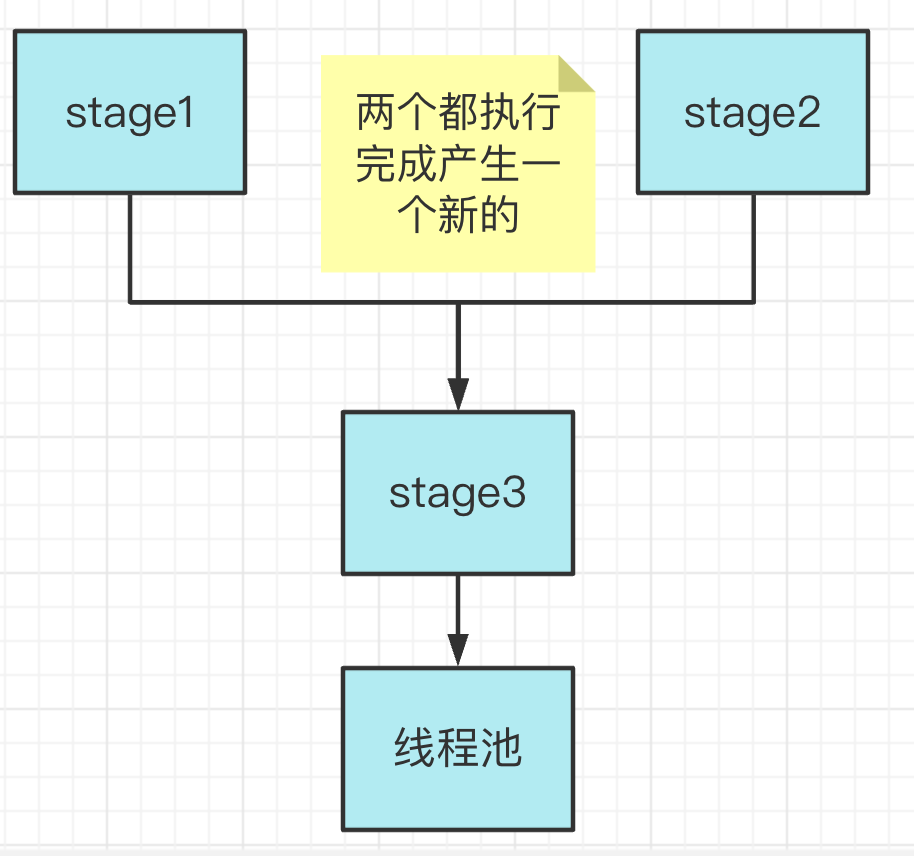
or聚合关系
// 当目前的CompletionStage和传入的CompletionStage其中一个正常完成后,返回一个新的CompletionStage,并执行fn 有返回值
public <U> CompletionStage<U> applyToEither
(CompletionStage<? extends T> other,
Function<? super T, U> fn);
// 当目前的CompletionStage和传入的CompletionStage其中一个正常完成后,返回一个新的CompletionStage,并执行action 这个无返回值,参数是Consumer
public CompletionStage<Void> acceptEither
(CompletionStage<? extends T> other,
Consumer<? super T> action);
// 任意一个执行完成,进行下一步操作,这个无传参
public CompletionStage<Void> acceptEitherAsync
(CompletionStage<? extends T> other,
Consumer<? super T> action);
- 1
- 2
- 3
- 4
- 5
- 6
- 7
- 8
- 9
- 10
- 11
- 12
- 13
- 14
总结
观察一下规律,所有的操作都封装成了一个CompletionStage,一个CompletionStage可以和另外一个CompletionStage产生关系,并且生成新的CompletionStage,并且可以设置发生异常或者正常完成时的操作,注意,这里操作分为三类:Function(有入参和出参)、Consumer(只有入参)、Runnable(没有入参和出参,仅仅执行动作)。并且我在其中省略了某些Async的异步操作,代表不同的CompletionStage可以在不同的线程池中执行。
深度解析
执行流程图

首先我们需要了解的是Completion和CompletableFuture是相互关联关系,也就是两个类互相作为对方的成员变量

可以从上面图中看出,要想执行完某个任务回调另一个任务,可以这样设计,把任务进行压栈,后面执行完才能回调之前的任务,栈的特点就是先进后出,这样考虑用栈完全符合。
源码分析
public static CompletableFuture<Void> runAsync(Runnable runnable) {
return asyncRunStage(asyncPool, runnable);
}
- 1
- 2
- 3
这里为什么不把任务直接放到线程池执行,线程池也是接收的这个类型的任务
因为Runnable里面没有东西能够回调stage动作,也就需要在外面包装一层来进行回调
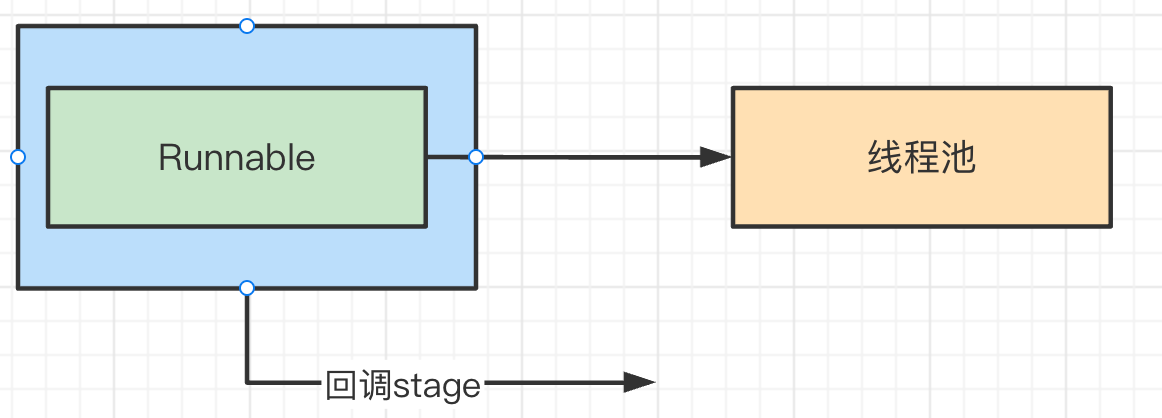
这里的代码就知道了为啥要对f变量进行包装了
asyncRunStage()
static CompletableFuture<Void> asyncRunStage(Executor e, Runnable f) {
if (f == null) throw new NullPointerException();
// 封装一个返回值为空的CF
CompletableFuture<Void> d = new CompletableFuture<Void>();
// 将d和f封装为AsyncRun放入线程池执行,这里想想为何要把d也封装进去呢?
// 很明显,因为我们可能需要在执行完毕后触发某个动作对吧
e.execute(new AsyncRun(d, f));
return d;
}
- 1
- 2
- 3
- 4
- 5
- 6
- 7
- 8
- 9
AsyncRun
static final class AsyncRun extends ForkJoinTask<Void>
implements Runnable, AsynchronousCompletionTask {
CompletableFuture<Void> dep; Runnable fn; // dep当前任务依赖的CF fn表示执行函数
AsyncRun(CompletableFuture<Void> dep, Runnable fn) {
this.dep = dep; this.fn = fn;
}
public final Void getRawResult() { return null; }
public final void setRawResult(Void v) {}
public final boolean exec() { run(); return true; }
public void run() {
CompletableFuture<Void> d; Runnable f;
// d = dep保留对象在栈上的引用 开始执行咱们的fn
if ((d = dep) != null && (f = fn) != null) { // 栈不为空且动作不为空
// 帮助gc
dep = null; fn = null;
if (d.result == null) { // 当d还没有完成的时候才开始执行,避免重复执行 result被volatile修饰
try {
f.run();
/**
* final boolean completeNull() {
* return Unsafe.compareAndSwapObject(this,
* RESULT, null,NIL);
* }
* 写上一个NIL对象:AltResult NIL = new
* AltResult(null);null表明没有出现异常
*/
d.completeNull();
} catch (Throwable ex) {
d.completeThrowable(ex);
}
}
// 调用postComplete完成CF
d.postComplete();
}
}
}
- 1
- 2
- 3
- 4
- 5
- 6
- 7
- 8
- 9
- 10
- 11
- 12
- 13
- 14
- 15
- 16
- 17
- 18
- 19
- 20
- 21
- 22
- 23
- 24
- 25
- 26
- 27
- 28
- 29
- 30
- 31
- 32
- 33
- 34
- 35
- 36
- 37
- 38
总结
我们看到当我们调用runAsync异步执行时,是将任务Runnable对象封装成AsyncRun对象放入线程池中执行。而AsyncRun继承自FJT,所以兼容在FJP中执行,当然AsyncRun也实现了Runnable接口,意味着我们也可以将其放到我们自定义线程池中执行。
这个类为什么要实现Runnable接口呢?不是已经继承FutureTask,可以直接执行了吗
在CompleteFuture里面不止ForkJoinPool线程池,还需要兼容其他线程池。
栈为什么用链表实现?
因为链表存储空间是不连续的,而且需要赋值的时候,不需要动态扩容。
我们看到当AsyncRun在线程池执行完成后,将会调用依赖的CompletableFuture 的postComplete方法完成回调操作。接下来我们来看当异步任务完成后回调依赖的CF完成链式操作的执行原理。
postComplete()
final void postComplete() {
CompletableFuture<?> f = this; Completion h;
/**
* 当前f所指CF中的stack不为空 或者 f变量和当前CF不匹配且当前任务的stack不
* 为空时执行。为什么会出现这样的情况?
* 来看一个场景:A->B->C;A->D
* 1.A执行完毕后执行B,B执行完毕后执行C。A执行完毕后也执行D
* 那么由于我们是调用栈的关系,所以这时肯定是先执行D的Completion
* 2.这时这里的变量f为A,h为D的Completion,接下来执行D的Completion且栈
* 顶变为D.next为B的Completion
* 3.再一次循环,这时f为A,h为B的Completion,执行B的Completion,这时由
* 于B的Completion有依赖C的CF变量,这时tryFire返回了C不为null,那么返回
* C作为变量f
* 4.再一次循环,这时f为C,h为C的stack的Completion,此时f != this,那
* 么将C的Completion压入到A的栈顶
* 5.继续循环,此时C的stack为null,且f(此时为C)!= this 那么将f变为A,
* A的stack为C的Completion,这时h为C的Completion,执行C的Completion
* 6.结束循环
*/
while ((h = f.stack) != null ||
(f != this && (h = (f = this).stack) != null)) {
CompletableFuture<?> d; Completion t;
// 取出栈顶的任务,并且将栈指针stack指向下一个任务
if (f.casStack(h, t = h.next)) {
// 取出的Completion t不为空
if (t != null) {
// 如果f变量和当前CF不是同一个,那么将h压回到栈顶
if (f != this) {
pushStack(h);
continue;
}
// h.next Completion已经取出来放到f所指的CF的stack中,这里不需要再保存next Completion
h.next = null; // detach
}
// 调用上面取出的Completion的tryFire方法,如果返回结果为空,那么返回当前CF,否则返回d
f = (d = h.tryFire(NESTED)) == null ? this : d;
}
}
}
- 1
- 2
- 3
- 4
- 5
- 6
- 7
- 8
- 9
- 10
- 11
- 12
- 13
- 14
- 15
- 16
- 17
- 18
- 19
- 20
- 21
- 22
- 23
- 24
- 25
- 26
- 27
- 28
- 29
- 30
- 31
- 32
- 33
- 34
- 35
- 36
- 37
- 38
- 39
这段代码的意思就是将任务反复压入栈中,然后执行完弹栈,直到栈为空为止。
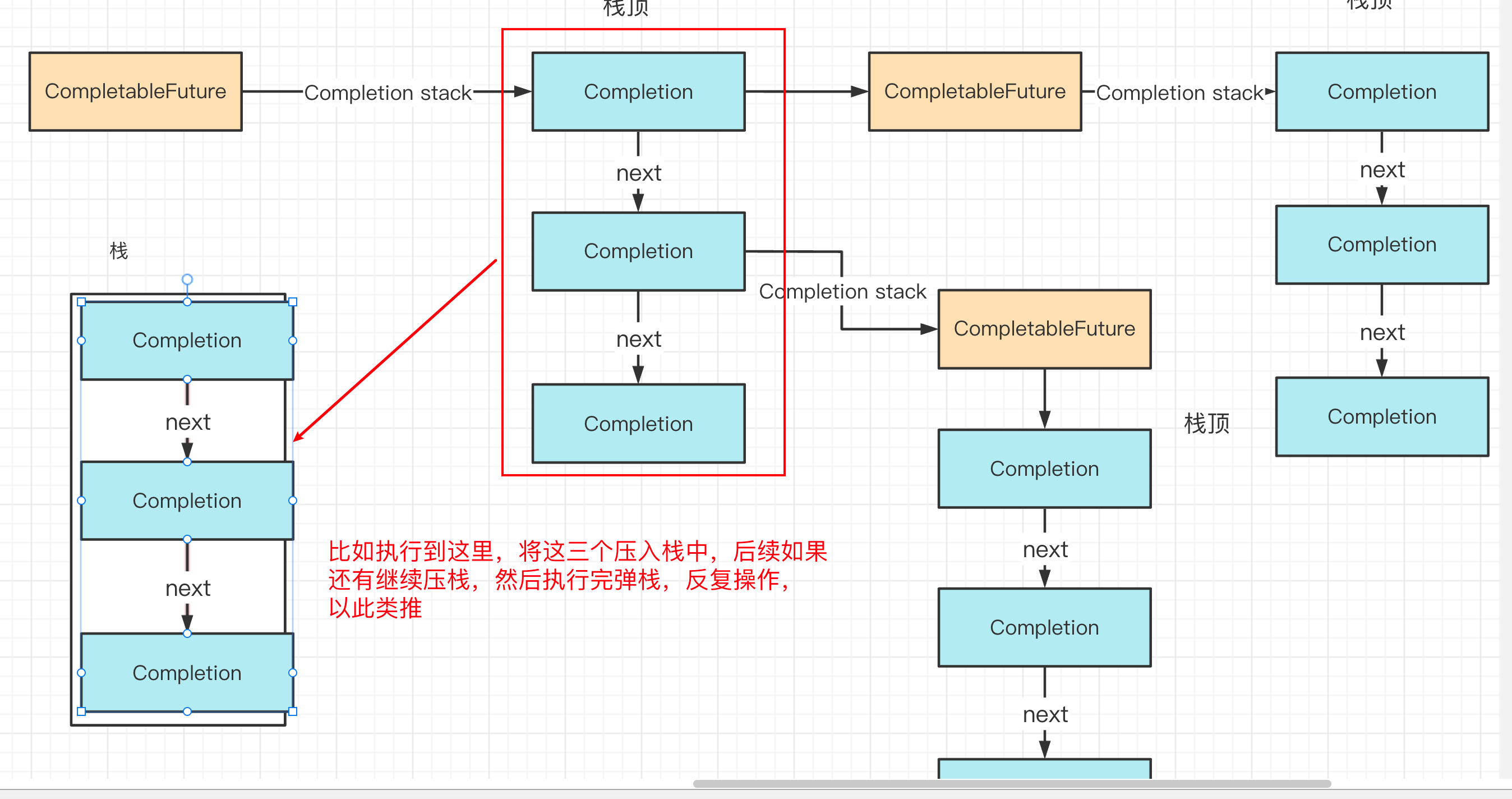
可以看到执行完毕后回调Completion执行回调动作,那么什么是Completion呢。
Completion原理
Completion英文翻译意思:完成。那么完成什么呢?来看,这里继承自ForkJoinTask,那么表明这个完成代表了一个动作,且这个动作可以放到FJP线程池中执行,同时,这里包含了一个next变量,同样也是一个Completion,将一串完成动作串起来了,同时这个结构是通过链表实现的栈结构。实现原理如下。
abstract static class Completion extends ForkJoinTask<Void>
implements Runnable, AsynchronousCompletionTask {
volatile Completion next; // Treiber stack link
/**
* 如果触发,则执行完成操作,返回可能需要传播的依赖项
* 参数可选:
* 1.SYNC = 1 同步执行
* 2.ASYNC = 0 异步执行
* 3.NESTED = -1 嵌套执行
*/
abstract CompletableFuture<?> tryFire(int mode);
// 如果依然还有动作需要执行,那么返回true
abstract boolean isLive();
// 执行tryFire,注意这里参数为ASYNC
public final void run() { tryFire(ASYNC); }
public final boolean exec() { tryFire(ASYNC); return true; }
public final Void getRawResult() { return null; }
public final void setRawResult(Void v) {}
}
- 1
- 2
- 3
- 4
- 5
- 6
- 7
- 8
- 9
- 10
- 11
- 12
- 13
- 14
- 15
- 16
- 17
- 18
- 19
- 20
- 21
- 22
由于上面的例子并没有添加回调动作,那么这里给出一个带有回调动作的例子。
CompletableFuture.runAsync(()->System.out.println("hello")).thenRun(()->System.out.println("over")).join(); // 执行完成后输出over操作
- 1
在上面我们看到asyncRunStage方法中返回了一个CompletableFuture代表无返回值的CF,那么我们这个的thenRun就是针对这个CF执行的,来看源码。
thenRun()
public CompletableFuture<Void> thenRun(Runnable action) {
// 注意这里传入的executor为null,表明同步执行
return uniRunStage(null, action);
}
- 1
- 2
- 3
- 4
uniRunStage()
private CompletableFuture<Void> uniRunStage(Executor e, Runnable f) {
if (f == null) throw new NullPointerException();
// 生成一个新的CF
CompletableFuture<Void> d = new CompletableFuture<Void>();
/**
* 执行线程池不为空或者调用uniRun执行失败,那么封装一个UniRun对象,调用push压入
* 当前CF的stack中。读者可能不太理解这里的为什么把新生成的CF称之为d,这里我给出d
* 的全称:dependent,这下明了了吧,叫做依赖项,确实是这样,毕竟需要等待当前CF执
* 行完毕才能执行。而且注意,这里如果传入了Executor,那么表明一定要异步执行,这时
* 必须封装UniRun,因为线程池中执行的必须是一个任务而不是一个CF。(在我们的例子中
* 仅仅只是输出了字符串,所以可能进入这里直接就d.uniRun执行输出over的操作)
*/
if (e != null || !d.uniRun(this, f, null)) {
UniRun<T> c = new UniRun<T>(e, d, this, f);
push(c); // 压入依赖栈
c.tryFire(SYNC); // 尝试执行
}
return d;
}
- 1
- 2
- 3
- 4
- 5
- 6
- 7
- 8
- 9
- 10
- 11
- 12
- 13
- 14
- 15
- 16
- 17
- 18
- 19
uniRun()
// 执行传入的Runnable
final boolean uniRun(CompletableFuture<?> a, Runnable f, UniRun<?> c) {
Object r; Throwable x;
// 父任务为空、父任务还没有执行完成、函数f为空均不执行,如果这时父CF a执行完了会立即调用f
if (a == null || (r = a.result) == null || f == null)
return false;
// 结果当前CF结果为null,表明没有执行完成
if (result == null) {
// 如果执行成功且包含异常,那么将异常赋值给当前CF的结果
if (r instanceof AltResult && (x = ((AltResult)r).ex) != null)
completeThrowable(x, r);
else
try {
// 如果任务UniRun c(completion)不为空,那么调用claim确认下是否应该执行该completion。如果不能执行,那么直接返回false
if (c != null && !c.claim())
return false;
f.run(); // 否则调用函数f
completeNull(); // 无返回值完成
} catch (Throwable ex) {
completeThrowable(ex);
}
}
return true;
}
- 1
- 2
- 3
- 4
- 5
- 6
- 7
- 8
- 9
- 10
- 11
- 12
- 13
- 14
- 15
- 16
- 17
- 18
- 19
- 20
- 21
- 22
- 23
- 24
push()
// 将Completion c压入当前CF的stack调用栈中
final void push(UniCompletion<?,?> c) {
// 当前CF还未完成且tryPushStack调用失败
if (c != null) {
while (result == null && !tryPushStack(c))
/**
* static void lazySetNext(Completion c, Completion next) {
* Unsafe.putOrderedObject(c, NEXT, next);
* }
*/
// 如果CAS失败,将C的next恢复为null
lazySetNext(c, null);
}
}
- 1
- 2
- 3
- 4
- 5
- 6
- 7
- 8
- 9
- 10
- 11
- 12
- 13
- 14
tryPushStack()
// 尝试通过CAS替换栈顶,读者可能会问:为什么是栈?想想LIFO(先进后出),不就正好满足咱们的要求吗?最后放入的action先执行
final boolean tryPushStack(Completion c) {
Completion h = stack; // 当前栈顶引用
lazySetNext(c, h); // 设置c的next为当前栈顶
return UNSAFE.compareAndSwapObject(this, STACK, h, c); // CAS替换栈顶引用
}
- 1
- 2
- 3
- 4
- 5
- 6
总结
生成了一个新的CF,然后通过传入的executor是不是null,看看是不是异步执行,如果不是,那么尝试调用uniRun直接执行回调动作,当然,如果此时父CF还未执行完成,那么将会通过push方法将任务放入栈顶,父CF执行完毕后弹出执行。注意,这里有一个临界情况,如果在push方法的while循环中任务执行成功了,那么这时任务没被压入栈中,那么谁来执行呢?很明显。uniRunStage方法中push方法后边调用了一次c.tryFire(SYNC)来解决这种临界条件。现在问题很明了了,集中在Completion的子类UniRun类中。这里直接看源码。
UniCompletion类
abstract static class UniCompletion<T,V> extends Completion {
Executor executor; // 异步执行时使用的执行器
CompletableFuture<V> dep; // 关联的CF
CompletableFuture<T> src; // 父CF
UniCompletion(Executor executor, CompletableFuture<V> dep,
CompletableFuture<T> src) {
this.executor = executor; this.dep = dep; this.src = src;
}
// 判断线程应该执行
final boolean claim() {
Executor e = executor;
// 使用FJT的tag标记位来实现只有一个线程可以设置执行
if (compareAndSetForkJoinTaskTag((short)0, (short)1)) {
// 如果执行器为空,那么直接返回true
if (e == null)
return true;
// 任务执行前将executor的引用释放,这时只需要局部变量的e持有引用
executor = null;
// 调用线程池执行当前Completion
e.execute(this);
}
return false;
}
// 是否有回调动作,如果关联的CF不为空的话,可能还有需要执行的Completion
final boolean isLive() { return dep != null; }
}
- 1
- 2
- 3
- 4
- 5
- 6
- 7
- 8
- 9
- 10
- 11
- 12
- 13
- 14
- 15
- 16
- 17
- 18
- 19
- 20
- 21
- 22
- 23
- 24
- 25
- 26
- 27
- 28
- 29
UniRun类
static final class UniRun<T> extends UniCompletion<T,Void> {
Runnable fn;
UniRun(Executor executor, CompletableFuture<Void> dep,
CompletableFuture<T> src, Runnable fn) {
// 初始化父类UniCompletion
super(executor, dep, src); this.fn = fn;
}
// 开始执行当前Completion
final CompletableFuture<Void> tryFire(int mode) {
CompletableFuture<Void> d; CompletableFuture<T> a;
// 如果关联的CF为空那么直接返回null,否则尝试执行依赖项的uniRun方法,如果执行失败同样返回
// 只有ASYNC异步执行才会将传入的UniRun设置为空
if ((d = dep) == null ||
!d.uniRun(a = src, fn, mode > 0 ? null : this))
return null;
// 释放引用
dep = null; src = null; fn = null;
// 成功执行后,将回调关联CF,让它执行调用栈stack的任务
return d.postFire(a, mode);
}
}
- 1
- 2
- 3
- 4
- 5
- 6
- 7
- 8
- 9
- 10
- 11
- 12
- 13
- 14
- 15
- 16
- 17
- 18
- 19
- 20
- 21
postFire()
// CompletableFuture方法,a为父CF,mode为触发执行Completion时的模式
final CompletableFuture<T> postFire(CompletableFuture<?> a, int mode) {
// 父CF不为空且执行栈不为空
if (a != null && a.stack != null) {
// NEST嵌套执行或者父CF还未完成
if (mode < 0 || a.result == null)
// 遍历调用栈并清除已经完成的Completion
a.cleanStack();
else
// 执行父任务的调用栈的Completion
a.postComplete();
}
// 当前任务已经执行完毕且调用栈不为空
if (result != null && stack != null) {
// 嵌套执行,返回当前CF对象,让根任务来执行当前CF的执行栈
if (mode < 0)
return this;
else
// 其它模式执行当前CF的调用栈
postComplete();
}
return null;
}
- 1
- 2
- 3
- 4
- 5
- 6
- 7
- 8
- 9
- 10
- 11
- 12
- 13
- 14
- 15
- 16
- 17
- 18
- 19
- 20
- 21
- 22
- 23
举例演示
thenRun()同步执行
看完了这个流程还是得以一个例子来说明这里面发生了什么,方便读者进行理解。
CompletableFuture<Void> future = CompletableFuture.runAsync(() -> {
System.out.println("hello");
try {
Thread.sleep(1000);
} catch (InterruptedException e) {
e.printStackTrace();
}
});
future.thenRun(() -> System.out.println("over1")).thenRun(() -> System.out.println("over11"));
future.thenRun(() -> System.out.println("over2")).thenRun(() -> System.out.println("over22")).join();
- 1
- 2
- 3
- 4
- 5
- 6
- 7
- 8
- 9
- 10
运行结果:
hello
over2
over22
over1
over11
工作流程如下所示。
主线程
runAsync方法中生成了一个新的CF-1,然后创建了一个FTJ任务AsyncRun,提交到FJP中执行在
FJP中执行AsyncRun的run方法,进而执行fn,此时当前线程睡眠1000主线程继续执行,此时调用
CF-1的thenRun方法,创建了一个新的CF-2,因为此时CF-1还没有执行完,那么创建一个Completion UniRun对象,将它放到CF-1的stack变量中主线程继续执行,调用
CF-2的thenRun方法,创建了一个新的CF-3,因为此时CF-2还没有执行完,那么创建一个Completion UniRun对象,将它放到CF-2的stack变量中。此时状态:CF-1.stack -> UniRun ( CF-2.stack -> UniRun( CF-3.stack -> null ) ) ; CF-1.stack = null主线程继续执行,此时调用
CF-1的thenRun方法,创建了一个新的CF-4,因为此时CF-1还没有执行完,那么创建一个Completion UniRun对象,将它放到CF-1的stack变量中主线程继续执行,调用
CF-4的thenRun方法,创建了一个新的CF-5,因为此时CF-4还没有执行完,那么创建一个Completion UniRun对象,将它放到CF-4的stack变量中。此时状态:CF-1.stack -> UniRun ( CF-4.stack -> UniRun( CF-5.stack -> null ) ) ;CF-1.stack.next -> UniRun ( CF-2.stack -> UniRun( CF-3.stack -> null ) )此时
FJP中的线程执行完毕AsyncRun传入的匿名函数,输出"hello",将CF-1的结果设置为AltResult对象调用
CF-1的postComplete方法,发现stack不为空,那么这时取出stack栈顶的Completion: UniRun ( CF-4.stack -> UniRun( CF-5.stack -> null ) )并设置stack变量为UniRun ( CF-2.stack -> UniRun( CF-3.stack -> null ) )开始执行
UniRun的tryFire方法,mode为NEST嵌套执行,然后执行传递进入的fn,输出"over2",将CF-4的结果设置为AltResult对象执行完毕后调用
CF-4的postFire方法,此时CF-4的结果为AltResult非空且mode为NEST,这时返回CF-4的引用给CF-1的postComplete方法循环局部变量f中继续执行
CF-1的postComplete方法,这时f为CF-4且它的stack不为空,指向UniRun( CF-5.stack -> null ),由于UniRun的next为null,这时继续执行UniRun,这时输出"over22",将CF-5的结果设置为AltResult对象,由于CF-5的stack为null,这时返回null,那么修正f变量指向CF-1循环以上过程进而输出
over1,over11
每个CompletableFuture对象都是一个CompletableStage且包含了两个核心变量:result(执行结果)、stack(执行完毕后回调的动作Completion。由于CF不是任务,这时需要一个任务来包装执行,这就是上面出现的AsyncRun。所以这里的FJT的子类包含两种类型:1.Completion 2.AsyncRun。当提交到FJP的任务AsyncRun执行完毕后,设置所包含的CF也即CompletableStage为完成状态,然后触发CF所包含的Completion即可。
那么上面我们是同步执行的例子,这里再给出一个异步执行的例子。
// 注意这里执行完调用的是thenRunAsync而不是thenRun
CompletableFuture.runAsync(()->System.out.println("hello")).thenRunAsync(()->System.out.println("over")).join();
- 1
- 2
thenRunAsync()异步执行
上面通过源码我们看到了:thenRun中的fn执行是在FJP的线程中执行和输出"hello"的线程是同一个(通过调用CF的postComplete,然后调用UniRun的tryFire执行),而这里的thenRunAsync会将后面输出"over"的fn放到另外的线程中异步执行。
thenRunAsync()
public CompletableFuture<Void> thenRunAsync(Runnable action) {
// 注意这里传入了asyncPool FJP线程池
return uniRunStage(asyncPool, action);
}
- 1
- 2
- 3
- 4
uniRunStage()
private CompletableFuture<Void> uniRunStage(Executor e, Runnable f) {
if (f == null) throw new NullPointerException();
CompletableFuture<Void> d = new CompletableFuture<Void>();
// 和thenRun的区别在于,这里由于e不为null,所以直接生成UniRun
if (e != null || !d.uniRun(this, f, null)) {
UniRun<T> c = new UniRun<T>(e, d, this, f);
push(c);
c.tryFire(SYNC);
}
return d;
}
- 1
- 2
- 3
- 4
- 5
- 6
- 7
- 8
- 9
- 10
- 11
tryFire()
// 在AsyncRun中最后调用了d.postComplete(),进而调用UniRun的tryFire(NESTED)方法:
final CompletableFuture<Void> tryFire(int mode) {
CompletableFuture<Void> d; CompletableFuture<T> a;
// 注意这里的mode为NESTED=-1,所以传入UniRun对象,线程池存在将会提交执行,并且返回false,所以该方法返回null
if ((d = dep) == null || !d.uniRun(a = src, fn, mode > 0 ? null : this))
return null;
dep = null; src = null; fn = null;
return d.postFire(a, mode);
}
- 1
- 2
- 3
- 4
- 5
- 6
- 7
- 8
- 9
uniRun()
// CF中的方法,前面也看到了用于执行UniRun 这个 Completion,特别注意这里的c不为空
final boolean uniRun(CompletableFuture<?> a, Runnable f, UniRun<?> c) {
Object r; Throwable x;
if (a == null || (r = a.result) == null || f == null)
return false;
if (result == null) {
if (r instanceof AltResult && (x = ((AltResult)r).ex) != null)
completeThrowable(x, r);
else
try {
// 这里是重点,如果线程池存在那么提交执行,那么返回false
if (c != null && !c.claim())
return false;
f.run();
completeNull();
} catch (Throwable ex) {
completeThrowable(ex);
}
}
return true;
}
- 1
- 2
- 3
- 4
- 5
- 6
- 7
- 8
- 9
- 10
- 11
- 12
- 13
- 14
- 15
- 16
- 17
- 18
- 19
- 20
- 21
UniRun中的claim()
// UniRun的方法
final boolean claim() {
Executor e = executor;
if (compareAndSetForkJoinTaskTag((short)0, (short)1)) {
if (e == null)
return true;
executor = null;
// 线程池中执行
e.execute(this);
}
return false; // 返回false
}
- 1
- 2
- 3
- 4
- 5
- 6
- 7
- 8
- 9
- 10
- 11
- 12
接下来,可以从源码角度来理解咱们的例子中的CF的使用方式了。我们逐步来分解。我们先来看getUserGrade方法。
static CompletableFuture<Integer> getUserGrade(String uid) {
// supplyAsync将任务放入线程池中执行,返回CompletableFuture
return CompletableFuture.supplyAsync(() -> {
try {
// 模拟获取数据延迟
Thread.sleep(500);
} catch (InterruptedException e) {
e.printStackTrace();
}
return 10;
});
}
// 和thenRunAsync唯一不同的是这里的参数为一个Supplier而不是一个Runnable
public static <U> CompletableFuture<U> supplyAsync(Supplier<U> supplier) {
return asyncSupplyStage(asyncPool, supplier);
}
static <U> CompletableFuture<U> asyncSupplyStage(Executor e,Supplier<U> f) {
if (f == null) throw new NullPointerException();
// 每一步都是一个CompletableStage,所以新生成一个CF
CompletableFuture<U> d = new CompletableFuture<U>();
// 这里不再是AsyncRun,变为了AsyncSupply代表f有返回值的异步任务
e.execute(new AsyncSupply<U>(d, f));
return d;
}
static final class AsyncSupply<T> extends ForkJoinTask<Void>
implements Runnable, AsynchronousCompletionTask {
CompletableFuture<T> dep; Supplier<T> fn;
AsyncSupply(CompletableFuture<T> dep, Supplier<T> fn) {
this.dep = dep; this.fn = fn;
}
public final Void getRawResult() { return null; }
public final void setRawResult(Void v) {}
public final boolean exec() { run(); return true; }
public void run() {
CompletableFuture<T> d; Supplier<T> f;
if ((d = dep) != null && (f = fn) != null) {
dep = null; fn = null;
if (d.result == null) {
try {
// 调用Supplier获取结果,并将结果放到当前绑定的CF中。对应到我们例子中就是用户的分数
d.completeValue(f.get());
} catch (Throwable ex) {
d.completeThrowable(ex);
}
}
// 同样执行依赖的CF的完成回调
d.postComplete();
}
}
}
- 1
- 2
- 3
- 4
- 5
- 6
- 7
- 8
- 9
- 10
- 11
- 12
- 13
- 14
- 15
- 16
- 17
- 18
- 19
- 20
- 21
- 22
- 23
- 24
- 25
- 26
- 27
- 28
- 29
- 30
- 31
- 32
- 33
- 34
- 35
- 36
- 37
- 38
- 39
- 40
- 41
- 42
- 43
- 44
- 45
- 46
- 47
- 48
- 49
- 50
- 51
- 52
- 53
- 54
- 55
allOf()
接下来是CompletableFuture.allOf(completableFutures)。该方法可以将所有的completableFutures组合成一个新的CompletableFuture,我们可以通过该方法返回的CompletableFuture等待所有任务执行完成。
public static CompletableFuture<Void> allOf(CompletableFuture<?>... cfs) {
return andTree(cfs, 0, cfs.length - 1);
}
- 1
- 2
- 3
andTree()
static CompletableFuture<Void> andTree(CompletableFuture<?>[] cfs,int lo,int hi) {
// 构建一个新的stage
CompletableFuture<Void> d = new CompletableFuture<Void>();
// 如果lo大于hi,表明数组为空,那么直接将结果设置为AltResult
if (lo > hi)
d.result = NIL;
else {
CompletableFuture<?> a, b;
// 找到中间索引,并分割左右CF
int mid = (lo + hi) >>> 1;
if ((a = (lo == mid ? cfs[lo] :andTree(cfs, lo, mid))) == null ||
(b = (lo == hi ? a : (hi == mid+1) ? cfs[hi] :andTree(cfs, mid+1, hi))) == null)
throw new NullPointerException();
// 判断a和b是否执行完毕
if (!d.biRelay(a, b)) {
// 创建BiRelay Completion
BiRelay<?,?> c = new BiRelay<>(d, a, b);
// 将BiRelay Completion放入到a任务的stack回调栈中
a.bipush(b, c);
// 为了避免添加进去期间任务已经执行完成,尝试手动执行一次,mode为SYNC同步执行
c.tryFire(SYNC);
}
}
return d;
}
- 1
- 2
- 3
- 4
- 5
- 6
- 7
- 8
- 9
- 10
- 11
- 12
- 13
- 14
- 15
- 16
- 17
- 18
- 19
- 20
- 21
- 22
- 23
- 24
- 25
接下来我们来看biRelay方法如何查询a和b CompletableFuture是否完成。实现过程如下。
BiRelay()
boolean biRelay(CompletableFuture<?> a,CompletableFuture<?> b) {
Object r, s; Throwable x;
// a或者b为null直接返回false,a和b任务和一个没有执行完毕返回false
if (a == null || (r = a.result) == null ||
b == null || (s = b.result) == null)
return false;
// 当前CF还没有执行
if (result == null) {
// 检测a和b执行的结果是否包含异常,如果含有异常,那么将异常结果设置为当前CF的结果
if (r instanceof AltResult && (x = ((AltResult)r).ex) != null)
completeThrowable(x, r);
else if (s instanceof AltResult && (x = ((AltResult)s).ex) != null)
completeThrowable(x, s);
else
// 正常结束
completeNull();
}
return true;
}
- 1
- 2
- 3
- 4
- 5
- 6
- 7
- 8
- 9
- 10
- 11
- 12
- 13
- 14
- 15
- 16
- 17
- 18
- 19
当我们发现a和b还未完成时,调用bipush方法将BiRelay Completion放入到a任务的stack回调栈中。实现过程如下。
bipush()
final void bipush(CompletableFuture<?> b, BiCompletion<?,?,?> c) {
if (c != null) {
Object r;
// 将c Completion压入当前stack中
while ((r = result) == null && !tryPushStack(c))
lazySetNext(c, null);
// b CF还没有完成
if (b != null && b != this && b.result == null) {
// 如果当前CF还未完成,那么封装CoCompletion赋值给q,否则直接将c赋值给q,将q压入b的stack中
Completion q = (r != null) ? c : new CoCompletion(c);
while (b.result == null && !b.tryPushStack(q))
lazySetNext(q, null);
}
}
}
- 1
- 2
- 3
- 4
- 5
- 6
- 7
- 8
- 9
- 10
- 11
- 12
- 13
- 14
- 15
接下来我们来看上面用到的两个Completion:BiCompletion、BiRelay的定义。
BiCompletion和BiRelay
// 包含两个src CompletableFuture的特殊UniCompletion
abstract static class BiCompletion<T,U,V> extends UniCompletion<T,V> {
CompletableFuture<U> snd;
BiCompletion(Executor executor, CompletableFuture<V> dep,
CompletableFuture<T> src, CompletableFuture<U> snd) {
super(executor, dep, src); this.snd = snd;
}
}
// 用于组合两个源CompletableFuture的结果,并且回调关联的CompletableFuture
static final class BiRelay<T,U> extends BiCompletion<T,U,Void> {
BiRelay(CompletableFuture<Void> dep,CompletableFuture<T> src,CompletableFuture<U> snd) {
// 强制设置executor为null
super(null, dep, src, snd);
}
final CompletableFuture<Void> tryFire(int mode) {
CompletableFuture<Void> d;
CompletableFuture<T> a;
CompletableFuture<U> b;
// 回调依赖的CF的biRelay方法完成CF
if ((d = dep) == null || !d.biRelay(a = src, b = snd))
return null;
src = null; snd = null; dep = null;
// 执行成功后回调
return d.postFire(a, b, mode);
}
}
- 1
- 2
- 3
- 4
- 5
- 6
- 7
- 8
- 9
- 10
- 11
- 12
- 13
- 14
- 15
- 16
- 17
- 18
- 19
- 20
- 21
- 22
- 23
- 24
- 25
- 26
- 27
这里可见将传入的所有CompletableFuture通过BiRelay Completion组合成一个回调执行树。拿我们这里的例子来说,CompletableFuture有三个。
// getUserIdList方法返回三个uid。从而生成三个CompletableFuture
List<String> uidList = new ArrayList<>();
uidList.add("1");
uidList.add("2");
uidList.add("3");
- 1
- 2
- 3
- 4
- 5
那么同样来描述一下流程。
主线程调用
allOf方法,间接调用andTree,这时cfs为上面三个uid调用getUserGrade生成的CompletableFuture数组,lo为0,hi为2创建一个新的
CompletableFuture,计算mid中间值d1 mid = (0 + 2) >>> 1 -> 1此时
lo != mid,那么递归一次进入andTree,这时lo为0,hi为1创建一个新的
CompletableFuture,计算mid中间值d2 mid = (0 + 1) >>> 1 -> 0此时
lo == mid将变量a = cfs[0],b = cfs[1]假如此时
a和b都没有完成,那么d2.biRelay(a, b)将返回false,那么创建BiRelay2( d2,a = cfs[0],b = cfs[1] ) Completion,压入a的stack中,返回d2此时在第一次进入
andTree的a = d2,b = cfs[3]继续调用
d.biRelay(a, b),假如此时a = d2或者b = cfs[3]都没有完成那么继续创建一个新的
BiRelay1(d1,a = d2,b = cfs[3]) Completion,将其压入a = d2的stack中返回d1如果此时,
cfs[0]完成执行了,那么回调BiRelay2 Completion,这时将执行BiRelay2的tryFire方法,间接调用d2的biRelay,因为此时cfs[1]未完成,所以直接返回如果此时,
cfs[1]完成执行了,那么回调BiRelay2 Completion,这时将执行BiRelay2的tryFire方法,间接调用d2的biRelay,因为此时cfs[0]已经完成,所以设置d2完成由于
d2完成,那么回调BiRelay1 Completion,由于cfs[3]还未完成,这时直接返回如果此时,
cfs[3]完成执行了,那么回调BiRelay1 Completion,由于d2已经完成,那么设置d1也为完成状态,然后回调d1的postFire方法继续执行设置的Completion
接下来我们继续看thenApply方法做了什么。
CompletableFuture.allOf(completableFutures)
.thenApply(v -> Stream.of(completableFutures).map(future -> {
try {
return future.get(); // 获取任务结果
} catch (Exception e) {
throw new RuntimeException(e);
}
}).collect(Collectors.toList())).whenComplete((userGradeList, e) -> {
if (e != null) {
throw new RuntimeException(e);
}
System.out.println(userGradeList);
}).join(); // 等待任务执行完毕
- 1
- 2
- 3
- 4
- 5
- 6
- 7
- 8
- 9
- 10
- 11
- 12
- 13
thenApply()
// CF的thenApply方法
public <U> CompletableFuture<U> thenApply(
// 注意这里是Function有输入和输出
Function<? super T,? extends U> fn) {
// 传入Executor为null,表明同步执行(FJP中执行TASK回调tryFire方法的线程)
return uniApplyStage(null, fn);
}
- 1
- 2
- 3
- 4
- 5
- 6
- 7
uniApplyStage()
private <V> CompletableFuture<V> uniApplyStage(
Executor e, Function<? super T,? extends V> f) {
if (f == null) throw new NullPointerException();
// 生成新的stage
CompletableFuture<V> d = new CompletableFuture<V>();
// 此时d还未完成不调用
if (e != null || !d.uniApply(this,f,null)) {
// 生成UniApply Completion压入当前CF的stack中
UniApply<T,V> c = new UniApply<T,V>(e,d,this,f);
push(c);
c.tryFire(SYNC);
}
return d;
}
- 1
- 2
- 3
- 4
- 5
- 6
- 7
- 8
- 9
- 10
- 11
- 12
- 13
- 14
UniApply类
// 包含一个fn的特殊UniCompletion
static final class UniApply<T,V> extends UniCompletion<T,V> {
Function<? super T,? extends V> fn;
UniApply(Executor executor, CompletableFuture<V> dep,CompletableFuture<T> src, Function<? super T,? extends V> fn) {
super(executor, dep, src); this.fn = fn;
}
// 当CF完成后回调
final CompletableFuture<V> tryFire(int mode) {
CompletableFuture<V> d; CompletableFuture<T> a;
// 调用uniApply
if ((d = dep) == null ||
!d.uniApply(a = src, fn, mode > 0 ? null : this))
return null;
dep = null; src = null; fn = null;
return d.postFire(a, mode);
}
}
- 1
- 2
- 3
- 4
- 5
- 6
- 7
- 8
- 9
- 10
- 11
- 12
- 13
- 14
- 15
- 16
- 17
uniApply()
// 执行传入的函数f
final <S> boolean uniApply(CompletableFuture<S> a,Function<? super S,?extends T> f, UniApply<S,T> c) {
Object r; Throwable x;
if (a == null || (r = a.result) == null || f == null)
return false; // 所压入的CF必须执行完成才能回调
tryComplete: if (result == null) { // 当前关联的cf必须还未执行完成
// 如果压入的CF结果包含异常,那么设置异常结果后返回。注意这里用java的标签当C语言的goto使用
if (r instanceof AltResult) {
if ((x = ((AltResult)r).ex) != null) {
completeThrowable(x, r);
break tryComplete;
}
// 否则不持有a的结果引用,帮助GC执行
r = null;
}
try {
// 是异步执行,那么这里通过claim提交线程池执行
if (c != null && !c.claim())
return false;
// 将r转为函数接受的泛型s,注意这里为null
@SuppressWarnings("unchecked") S s = (S) r;
// 然后调用函数设置当前cf的完成结果为函数返回值
completeValue(f.apply(s));
} catch (Throwable ex) {
completeThrowable(ex)
}
}
return true;
}
- 1
- 2
- 3
- 4
- 5
- 6
- 7
- 8
- 9
- 10
- 11
- 12
- 13
- 14
- 15
- 16
- 17
- 18
- 19
- 20
- 21
- 22
- 23
- 24
- 25
- 26
- 27
- 28
- 29
whenComplete()
CompletableFuture.allOf(completableFutures)
.thenApply(v -> Stream.of(completableFutures).map(future -> {
try {
// 获取任务结果
return future.get();
} catch (Exception e) {
throw new RuntimeException(e);
}
}).collect(Collectors.toList()))
// 当CF执行完后回调,userGradeList为CF的运行结果,e为执行过程中的异常
.whenComplete((userGradeList, e) -> {
if (e != null) {
throw new RuntimeException(e);
}
System.out.println(userGradeList);
// 等待任务执行完毕
}).join();
// CF方法,执行完回调
public CompletableFuture<T> whenComplete(
// 注意这里为BiConsumer表明两个输入项:结果、异常
BiConsumer<? super T, ? super Throwable> action) {
// 同步执行
return uniWhenCompleteStage(null, action);
}
- 1
- 2
- 3
- 4
- 5
- 6
- 7
- 8
- 9
- 10
- 11
- 12
- 13
- 14
- 15
- 16
- 17
- 18
- 19
- 20
- 21
- 22
- 23
- 24
- 25
uniWhenCompleteStage()
private CompletableFuture<T> uniWhenCompleteStage(
Executor e, BiConsumer<? super T, ? super Throwable> f) {
if (f == null) throw new NullPointerException();
CompletableFuture<T> d = new CompletableFuture<T>();
if (e != null || !d.uniWhenComplete(this, f, null)) {
// 当前CF未完成封装Completion
UniWhenComplete<T> c = new UniWhenComplete<T>(e, d, this, f);
// 压入栈顶stack变量
push(c);
c.tryFire(SYNC);
}
return d;
}
- 1
- 2
- 3
- 4
- 5
- 6
- 7
- 8
- 9
- 10
- 11
- 12
- 13
UniWhenComplete类
// WhenComplete封装,包含一个BiConsumer变量的UniCompletion
static final class UniWhenComplete<T> extends UniCompletion<T,T> {
BiConsumer<? super T, ? super Throwable> fn;
UniWhenComplete(Executor executor, CompletableFuture<T> dep,
CompletableFuture<T> src,
BiConsumer<? super T, ? super Throwable> fn) {
super(executor, dep, src); this.fn = fn;
}
final CompletableFuture<T> tryFire(int mode) {
CompletableFuture<T> d; CompletableFuture<T> a; // 执行关联的CF的uniWhenComplete
if ((d = dep) == null || !d.uniWhenComplete(a = src, fn, mode > 0 ? null : this))
return null;
dep = null; src = null; fn = null;
return d.postFire(a, mode);
}
}
- 1
- 2
- 3
- 4
- 5
- 6
- 7
- 8
- 9
- 10
- 11
- 12
- 13
- 14
- 15
- 16
uniWhenComplete()
// CF的WhenComplete完成回调
final boolean uniWhenComplete(CompletableFuture<T> a,
BiConsumer<? super T,? super Throwable> f,
UniWhenComplete<T> c) {
Object r; T t; Throwable x = null;
if (a == null || (r = a.result) == null || f == null)
return false;
if (result == null) {
try {
// 异步执行
if (c != null && !c.claim())
return false;
if (r instanceof AltResult) {
// 获取执行异常
x = ((AltResult)r).ex;
// AltResult的执行结果为null
t = null;
} else {
// 不为AltResult,设置t为执行结果
@SuppressWarnings("unchecked") T tr = (T) r;
t = tr;
}
// 调用f消费,执行结果t和执行异常
f.accept(t, x);
// 如果执行异常为空,那么将当前cf的结果完成为运行结果
if (x == null) {
internalComplete(r);
return true;
}
} catch (Throwable ex) {
if (x == null)
x = ex;
}
// 出现异常,设置为异常完成
completeThrowable(x, r);
}
return true;
}
- 1
- 2
- 3
- 4
- 5
- 6
- 7
- 8
- 9
- 10
- 11
- 12
- 13
- 14
- 15
- 16
- 17
- 18
- 19
- 20
- 21
- 22
- 23
- 24
- 25
- 26
- 27
- 28
- 29
- 30
- 31
- 32
- 33
- 34
- 35
- 36
- 37
- 38
总结
接下来可以对CompletableFuture进行总结了:
-
将每一个动作封装为
CompletionStage,为CompletionStage的实现 -
每个
CompletableFuture都有一系列的同步方法和异步方法,命名为:xxx和xxxAsync -
每个
CompletableFuture拥有一个stack执行栈,包含一系列的Completion,每个Completion和一个CompletableFuture关联 -
初始通过
CompletableFuture放入的根任务,通过封装为AsyncRun进行执行 -
当每个
CompletableFuture执行完毕后,如果当前stack执行栈不为空,那么依次回调栈内的Completion,Completion执行完毕后,如果这个Completion关联的CompletableFuture不为空,那么继续回调,直到所有Completion全部执行完毕


评论记录:
回复评论: